





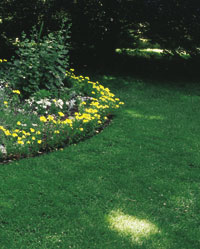
It's an instant fix and, when properly installed, sod eliminates problems with soil erosion, mud, and weeds. And you can lay it almost any time during the growing season.
Professionally raised grass in high-quality sod is sturdy and dense from the outset and is usually weed-free. You can find sod in several of the most common grasses for your area. Although the initial cost of sod is considerably more than grass seed -- especially if you hire a contractor to lay it -- seeding costs about the same in the long run since you have to overseed in spring and fall following the initial seeding to grow a dense lawn.
Think of your lawn as a garden of grass. Before planting, prepare the soil as you would any garden bed. Add plenty of organic matter so the soil will retain moisture, yet drain well. Aerate it to encourage microbial activity. Once the sod is planted, deep watering is essential -- the water must penetrate 6 inches below the sod -- to encourage roots to penetrate deeply as they knit the sod to the soil. Pay attention to the seams between pieces of sod and the edges along walks and drives, and water them carefully because they dry out quickly.
Still not sure between sod and seed to lay a new lawn? Our grass seed calculator can help you figure out how much seed you'll need.
continue reading belowFresh, healthy sod is the key to a successful sod lawn. Because the grass in commercial sod is professionally grown in top-quality soil that receives regular fertilizing and watering, it is sturdy, dense, and weed-free.
Sod should be newly harvested -- ideally within a day before it's laid. Arrange for it to be delivered as soon as you've finished preparing the soil. The sod will arrive piled on pallets in rolled or folded strips, with the soil side exposed. The strips of sod are generally 1 to 2 feet wide and 4 to 10 feet long.
Unroll a strip to inspect it. The grass should be at least 2 inches long and of a uniform green color. The soil on the underside should be dark and moist, about 1 inch thick, and show a tight matrix of healthy roots.
Store the pallets in the shade. Keep the pieces of sod moist, and cover them to avoid drying out in case there's an unexpected delay.
Sod is available in many types of grass. If you're doing a patching job, try to find a sod with grass that resembles the color and texture of the grass surrounding the patch. When in doubt, compromise by choosing a mixture of grass types.
An advantage to sodding is that it gives you an opportunity to introduce a new grass blend or mixture that's appropriate for your site. If it's an area that gets a lot of foot traffic, use a mixture that features tall fescue, which stands up best to wear and tear. Or if the area is primarily for display, a blend of Kentucky bluegrasses may look elegant.
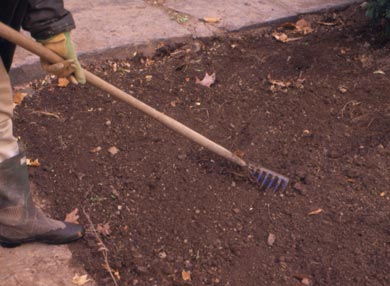 Step 1
Step 1
1. Establish a bed an inch below grade so the new lawn will be even with walkways. Dig organic material and slow-acting, granular fertilizer into the soil, then rake the bed smooth and level.
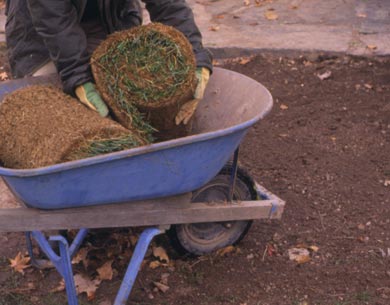 Step 2
Step 2
2. Store the sod in the shade; keep it rolled and moist until you're ready to use it. Bring one or two rolls at a time to the site in a wheelbarrow or cart. Moisten the soil bed just before laying the sod.
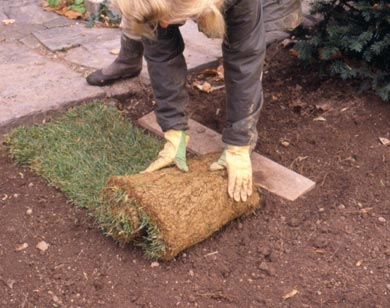 Step 3
Step 3
3. Lay the first length of sod along a straight edge such as a sidewalk. Unroll the grass strip gently, placing it snugly against the walk. Start the second roll of sod so its end neatly abuts the first.
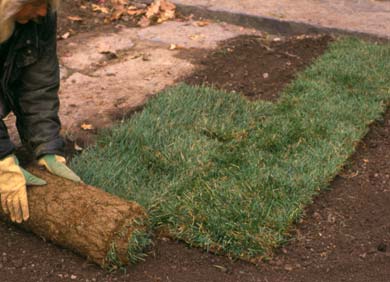 Step 4
Step 4
4. Lay subsequent rows so the end seams are never flush with those of adjacent rows. Coax the edges as close together as possible, but don't stretch them.
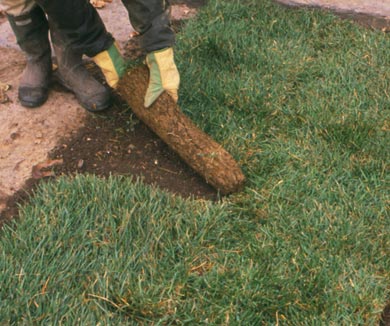 Step 5
Step 5
5. Don't stand on newly planted sod; instead use a kneeling board to lay additional rows. Use a sturdy knife to cut sod to fit irregular spaces.
6. Tamp the sod, or gently use a roller to establish good root contact with the soil. Fill any gaps with loose soil. Generously water the entire lawn.
For best results, lay sod in the spring or fall when there's likely to be more rainfall to help the lawn become established. However, you can patch bare spots in existing lawns any time of the year that the ground isn't frozen. Be prepared to water often during the hot summer months.
Copyright © www.100flowers.win Botanic Garden All Rights Reserved